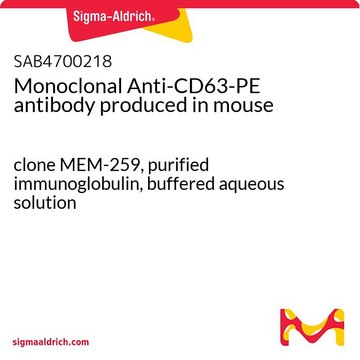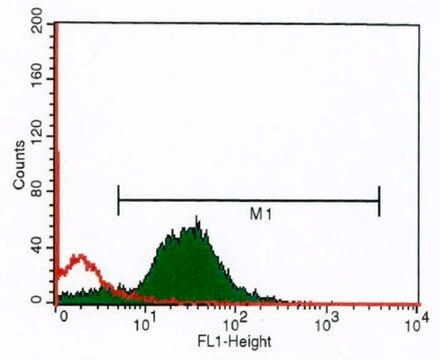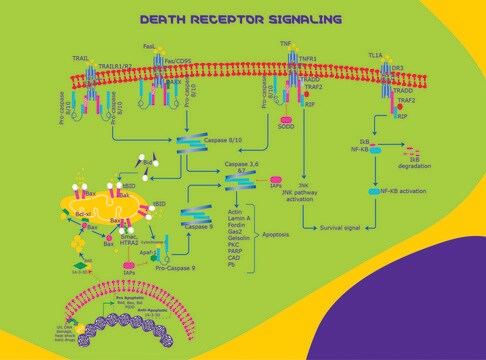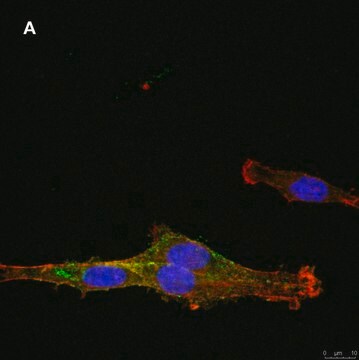SAB4700005
Monoclonal Anti-CD95 antibody produced in mouse
clone LT95, purified immunoglobulin, buffered aqueous solution
Synonim(y):
Anti-FAS
Zaloguj sięWyświetlanie cen organizacyjnych i kontraktowych
About This Item
Kod UNSPSC:
12352203
NACRES:
NA.41
białko sprzężone:
unconjugated
application:
FACS
klon:
LT95, monoclonal
reaktywność gatunkowa:
human
citations:
6
metody:
flow cytometry: suitable
Polecane produkty
pochodzenie biologiczne
mouse
Poziom jakości
białko sprzężone
unconjugated
forma przeciwciała
purified immunoglobulin
rodzaj przeciwciała
primary antibodies
klon
LT95, monoclonal
Formularz
buffered aqueous solution
reaktywność gatunkowa
human
stężenie
1 mg/mL
metody
flow cytometry: suitable
izotyp
IgG1
numer dostępu NCBI
numer dostępu UniProt
Warunki transportu
wet ice
temp. przechowywania
2-8°C
docelowa modyfikacja potranslacyjna
unmodified
informacje o genach
human ... FAS(355)
Powiązane kategorie
Opis ogólny
CD95, also known as Fas (fatty acid synthase) cell surface death receptor/APO-1, is encoded by the gene mapped to human chromosome 10q23.31. The encoded protein belongs to the tumor necrosis factor receptor superfamily and is expressed on a variety of cells including activated T and B cells. CD95 contains a death domain.
The antibody LT95 reacts with CD95 (Fas/APO-1), a 46 kDa single chain type I glycoprotein of the tumour necrosis factor/nerve growth factor (TNF/NGF) receptor superfamily, expressed on a variety of normal and neoplastic cells. It seems that the antibody LT95 does not induce Fas mediated apoptosis, although it cross-blocks anti-Fas DX2 antibody that recognizes a functional epitope of Fas molecule.
Immunogen
HUT-78 human T cell lymphoma cell line
Zastosowanie
Monoclonal Anti-CD95 antibody produced in mouse has been used as a apoptosis inducer.
Działania biochem./fizjol.
CD95/ Fas (fatty acid synthase) cell surface death receptor interacts with its natural ligand (FasL/CD95 L) and plays a vital role in regulation of T-cell homeostasis, by promoting apoptosis via activation-induced cell death (AICD). Mutation in the gene has been associated with the development of Sézary syndrome (SS) and Canale–Smith syndrome. CD95 gene loss can be used as a genetic marker of PSA recurrence after radical prostatectomy.
Cechy i korzyści
Evaluate our antibodies with complete peace of mind. If the antibody does not perform in your application, we will issue a full credit or replacement antibody. Learn more.
Postać fizyczna
Solution in Tris buffered saline, pH 8.0, with 15 mM sodium azide.
Ta strona może zawierać tekst przetłumaczony maszynowo.
Nie możesz znaleźć właściwego produktu?
Wypróbuj nasz Narzędzie selektora produktów.
Kod klasy składowania
10 - Combustible liquids
Klasa zagrożenia wodnego (WGK)
WGK 1
Temperatura zapłonu (°F)
Not applicable
Temperatura zapłonu (°C)
Not applicable
Wybierz jedną z najnowszych wersji:
Masz już ten produkt?
Dokumenty związane z niedawno zakupionymi produktami zostały zamieszczone w Bibliotece dokumentów.
Downregulation of Fas Gene Expression in Sezary Syndrome Is Associated with Promoter Hypermethylation
Jones CL
The Journal of Investigative Dermatology, 130, 1116-1125 (2010)
Chlorpyrifos and Cypermethrin Induce Apoptosis in Human Neuroblastoma Cell Line SH-SY5Y
Raszewski G
Basic and Clinical Pharmacology and Toxicology, 116, 158-167 (2015)
Cytotoxicity-dependent APO-1 (Fas/CD95)-associated proteins form a death-inducing signaling complex (DISC) with the receptor.
Kischkel FC
The Embo Journal, 14, 5579-5588 (1995)
Exploring prostate cancer genome reveals simultaneous losses of PTEN, FAS and PAPSS2 in patients with PSA recurrence after radical prostatectomy.
Ibeawuchi C
International Journal of Molecular Sciences, 16, 3856-3869 (2015)
Katrin A Salva et al.
Photochemistry and photobiology, 94(5), 1058-1065 (2018-04-21)
Aminolevulinate-based photodynamic therapy (ALA-PDT) selectively eliminates diseased tissues primarily through the induction of intrinsic apoptotic pathway. ALA-PDT is a first-line therapy for actinic keratosis, however, it is less effective for cutaneous T-cell lymphoma (CTCL). We have previously demonstrated that the
Nasz zespół naukowców ma doświadczenie we wszystkich obszarach badań, w tym w naukach przyrodniczych, materiałoznawstwie, syntezie chemicznej, chromatografii, analityce i wielu innych dziedzinach.
Skontaktuj się z zespołem ds. pomocy technicznej






